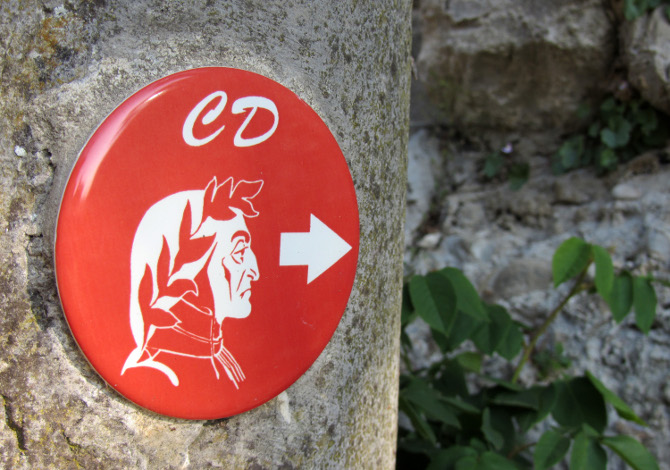Dante’s Path is a real trekking from Florence to Ravenna which straddles the Apennines and ideally retraces the paths along which the Poet passed during his exile during which he wrote the Divine Comedy. Dante’s Way is a recent invention, and there is no historical certainty that Dante traveled exactly those roads on his journey between Florence and Ravenna. However, the Casentinesi Forests, the castles of the Guidi Counts and the hills of Romagna are the areas where Dante lived in the last years of his life and where he wrote the Poem, with many places mentioned among the tercets and still recognizable today.
Dante’s Way: how long is the trek from Florence to Ravenna
Dante’s Way is basically a ring, with departure and/or arrival at the Dante’s House Museum in Florence and Dante’s Tomb in Ravenna. Wanting to cover it all, it is about 380 km for a total of 20 stages divided between the two variants which from Florence and Ravenna head towards the Valle del Lamone (more or less following the path of the 100 km of the Passatore) the other the Valle del Montone. Moreover, both variants cross the Alta Via Dei Parchi, the modern route of the Great Apennine Traversata, in various points, and curiously the variant which passes through the Valle del Lamone coincides for many stretches with the Sentiero Garibaldi, the route taken by the Risorgimento patriot during the so-called Trafila when, in August 1849, fleeing from the Austrians and unable to reach Venice, Garibaldi climbs the Apennines towards the Grand Duchy of Tuscany and then Liguria and salvation.
Dante’s Way: the stages between Florence and Ravenna
Wanting to retrace Dante’s Way as the Poet did, one inevitably starts from Florence and proceeds counterclockwise, following the round red signpost with the poet’s effigy in white. From Florence go up to San Miniato al Monte, also mentioned in Purgatory (As on the right hand to climb the mountain / where the church sits subduing the well-guided above Rubaconte / the bold enthusiasm breaks down in mounting for the stairs that took place at an age / which was sure and the notebook and the stave) and continue for San Piero a Sieve, Scarperia and nearby Sant’Agatain whose castle belonging to the Ubaldini family Dante probably stayed in 1302. From here you descend from the Colla pass in the direction of San Benedetto in Alpe and the Acquacheta waterfall (Like that river that has its own path / first from Monte Viso ‘nver’ east, / from the left side of the Apennines, / which is called Acquacheta up, forward / which descends down to the lower bed, / and in Forlì of that name it is vacant, / it rumbles there above San Benedetto / de l’Alpe to fall to a descent / where it was supposed to be sheltered by a thousand; / thus, down a steep bank, / we found that tinted water resonating, / so that in a few hours his ear would be offended) to then reach Marradi, home of good marron.
Here the province of Florence and Tuscany ends and you enter the province of Ravenna and Romagna passing through Brisighella, with its interesting excursion along the Vena del Gesso, until arriving in Faenza and the plain from where you can reach Ravenna. The return to Florence can be done with the so-called Dante’s train, or Faentina line, a trans-Apennine railway in operation since 1893, or follow the variant of the Dante’s Way in the Montone Valley. The other part of the ring goes up from Forlì through Dovadola, Portico di Romagna and Premilcuore to then reach the Calla Pass and the Forlì Refuge, a point of access to the Casentino Forests and the Sasso Fratino reserveone of the oldest and most fascinating wild areas in Italy.
How to organize yourself to do the Camino di Dante
Dante’s Way, at least in its Apennine section, crosses sparsely inhabited areas and with enormous naturalistic charm. Beech and chestnut groves are the masters together with a wildlife still present, from wild boars to roe deer and even the wolf, recently sighted right in the Casentino Forests in the company of a fox. Along the way there is no shortage of bivouacs and huts, if you want to do everything independently, and even some shelters which, together with B&Bs and farmhouses, represent an interesting form of widespread accommodation. However, in the summer it is advisable to book in time and make sure that the structures are open in order not to run the risk of finding yourself in isolated and remote areas without the possibility of staying overnight. A good solution may be to contact the organizers of the Camino directly at this link.
Advertising
